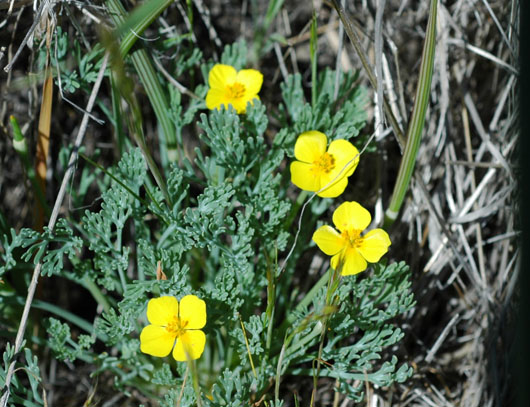Diamond-petaled California poppy flourishes at Site 300
Thought to be extinct for about 40 years, a rare plant has been anything but scarce this spring — at least in one location, Site 300.
The diamond-petaled California poppy was believed to be extinct until it was rediscovered in 1992 in the Carrizo Plain in San Luis Obispo County by a botanist from Cal Poly, San Luis Obispo.
Five years later, in 1997, botanical surveys conducted to obtain background information for the 2005 Site-wide Environmental Impact Statement for continued operation of LLNL led to the discovery of the second population of this species at Site 300.
In succeeding years, in 2002 and 2004, two small additional populations were discovered, also at Site 300, the 7,000-acre rolling grasslands area, 15 miles east of Livermore.
These are the only locations — Site 300 and San Luis Obispo County’s Carrizo Plain — where the diamond-petaled California poppy currently is known to grow worldwide.
Typically, the cumulative population of this plant at Site 300 includes less than 1,000 plants each year, according to ecologist Lisa Paterson of the Laboratory’s Environmental Protection Department.
But that hasn’t happened this year. Paterson and her colleagues estimate that this spring the three remote populations at Site 300 contain between 8,000 and 10,000 diamond-petaled California poppies.
"This has been a great year for the poppy," Paterson said. "There have been close to 10 times as many plants this spring as in each of the previous 10 years of monitoring."
The size of annual plant populations, such as the diamond-petaled California poppy, vary greatly from year to year. Paterson believes that Northern California’s steady, even rainfall this year is the most likely explanation for the explosion of diamond-petaled California poppies, although she adds that she and others aren’t certain that’s the reason.
Since 1993, LLNL has had a program at Site 300 to monitor rare plant populations and study the ecological causes of rarity in these species.
"Once we have a better understanding of why these plants are rare, we hope to use this information to better manage and protect these extremely rare species," Paterson said.
A short-lived annual plant, the diamond-petaled California poppy started blooming this year at Site 300 in late March and is expected to continue blooming for another few days to a week, Paterson said.
Typically smaller than 15 centimeters (or about six inches) when flowering, the plant has small yellow flowers with roughly diamond-shaped petals and is a close relative of the bright orange California poppy.
The diamond-petaled California poppy has not been seen on the Carrizo Plain in San Luis Obispo County between 1995 and 2007.
All three diamond-petaled California poppy populations at Site 300 grow in remote areas away from the facility’s small number of developed areas.
"The management at Site 300 goes out of its way to protect these rare plants and invests money in the monitoring and research for them," Paterson said.
"Site 300 is a unique, interesting place. We appreciate the chance to work with plants that occur naturally in only a few places. Most importantly, we want to help protect these plants and ensure that they survive."
The diamond-petaled California poppy is one of the rarest plants in California and probably never was widespread. Only seven historic populations are known in the inner coast ranges in Contra Costa, Stanislaus, San Luis Obispo and Colusa counties.
Three other rare plants also can be found at Site 300: the round-leaved filaree, the big tarplant and the large-flowered fiddleneck. The large-flowered fiddleneck is listed as endangered under the federal and California endangered species acts. The large-flowered fiddleneck has a colorful orange flower and grows on about one-sixth of an acre at Site 300.
The large-flowered fiddleneck is known to exist naturally in only two locations worldwide — at Site 300 and on a privately-owned ranch in Carnegie Canyon, near Site 300.
For a look at the large-flowered fiddleneck, see Newsline.






